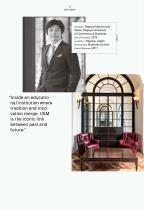 Website:
USM Modular Furniture
Website:
USM Modular Furniture
Catalog excerpts

YOURS! EDITION
Open the catalog to page 1
MakE IT YOURS – EDITION NO 1 Dear reader, In 2015, the USM Haller modular furniture system celebrated its 50 th anniversary. The milestone has sparked reflection at USM: How did it all begin? And what does the future have in store? Of course, we can argue that USM Haller’s simple aesthetic design has not aged one bit. But is it still as appealing to our young, and not so young, customers? It would appear so when reading this new magazine. Both at home and in the office, the tubular system fits in, stands out, takes over or blends in discreetly with its surroundings. From appetizing recipes...
Open the catalog to page 3
BE ICONIC A piece of USM furniture is a statement. As a design icon, it is timeless and it draws in your eye without distracting your focus. MIX IT It’s boring when everything is the same. That’s why USM adjusts easily to different styles and looks as great in a classic setting as it does alongside modern architecture. Iconic architecture Tradition and innovation, permanence and change Setting the stage in style What is typically Swiss? KEEP IT SIMPLE Life is complicated enough, so ideas that simplify it can really help. Well-designed furniture solutions allow for better organization and...
Open the catalog to page 4
SMARTER TOGETHER We share the longer the more, also in our work life: a space, infrastructure, network and expertise, all while staying independent. USM combines inherently individual solutions with a clear overall concept. KNOW YOUR CLASSICS Good design is timeless. It conveys confidence and lasting values. USM is a sign of true classics with a strong heritage. Where would I like to work today? The creative hub: where ideas meet friends From nightlife to work days Dividing space, connecting people Free-flowing ideas and flat hierarchies STAND UP FOR YOUR HEALTH Good working and living...
Open the catalog to page 5
ICONIC ARCHITEC … and USM is a part of it
Open the catalog to page 6
In Learning from Las Vegas, Robert Venturi and Denise Scott-Brown’s classic book about architectural theory, “I AM A MONUMENT” appears in large letters on a drawing of an inconspicuous office building that would like to be more than it is. This is the dream that drives many builders and architects: to overcome, for once, the banality of everyday life; to create a monument, an icon, a landmark that makes its way into architectural history because it has become a meaningful symbol for an cultural institution or company, or because it forever defines a city. In the past, only great rulers were...
Open the catalog to page 8
Frequently, the identity of cities edges into our memories through milestones of architecture: Who does not associate the Eiffel Tower with Paris? The Empire State Building with New York? What would Sydney be without its opera house? And what could Bilbao thank for its rise from an ordinary city to a cultural metropolis if not the Guggenheim museum? It is most certainly not a coincidence that we see USM represented in so many influential structures built in the last few years. What would be a better fit for an architectural icon than a classic and timeless design icon? For this reason, USM...
Open the catalog to page 10
© Iwan Baan 2014 © Gehry partners LLP
Open the catalog to page 11
Tradition and innovation, Permanence and Change
Open the catalog to page 12
To celebrate its 80th anniversary, the Nagoya University of Commerce & Business (NUCB) – part of the Kurimoto Education Institute – completed the Nagoya Marunouchi Tower in Nagoya’s Naka distri
Open the catalog to page 13
Nagoya Marunouchi Tower, Nagoya University of Commerce & Business Year of founding: 2015 Located in: Nagoya, Japan Working field: Business School Owns USM since: 2011 “Inside an educational institution where tradition and innovation merge, USM is the iconic link between past and future.”
Open the catalog to page 14
The new campus now houses NUCB Business School’s MBA program. The tower is designed around to the concept of merging innovation and tradition. As part of the design process, venerable business schools around the world were closely analyzed to identify elements that would be subject to changing times and those that would remain spatially and temporally unchanged. The key architectural characteristics of a business school were also taken into account. Combining traditional European and American styles with their own ideas, the designers fleshed out the theme for the new school. The first two...
Open the catalog to page 15
“A piece of furniture is not like a dress. I want furniture to last as long as possible.
Open the catalog to page 16
Pietro Russo Milan, Italy Occupation: Scenographer / designer Name: “There is unconditional style, and there are trends. Trends have a limited life, while true style is long-lasting.” Setting the stage in style Pietro Russo is a Milan-based scenographer from Ostuni, Puglia, who designs interiors and furniture in the same way that an old-school architect might. He takes a sensitive and harmonious approach to his work, believing that houses, like sets, should be designed with care, longevity and historical accuracy in mind. After all, a specially designed space or piece of furniture carries...
Open the catalog to page 17
TYPICALLY SWISS? Oeschinen Lake with the «I de Fründe» Coombe and Blüemlisalp, Oeschinenhorn, Fründenhorn, Doldenhorn mountains,
Open the catalog to page 18
Aspects of Swissness. Photographs by Bruno Augsburger, interpreted with the iconic USM Haller.
Open the catalog to page 19
Farmhouse at Stouffenbach, Thörigen
Open the catalog to page 20
Farmer, Appenzell
Open the catalog to page 21
I downsize, therefore I am There is a picture in Sebastian Küpers’ kitchen. The photo – of his grandfather – is the only picture in his apartment. It is also the only object he owns that does not perform a specific funct
Open the catalog to page 23
The average German owns around 10,000 things; Küpers possesses a small fraction of that number. He uses most of his belongings daily. He threw out everything that he had not used in three months and ended up with fewer than 100 things. Now he has a couple more. And after living in Airbnb apartments for a while, he returned to his own home and the things he owns. He feels content. But his longing for simplicity remains. Küpers says that he has never owned much. In his own words, “One will not achieve happiness by working harder and harder to buy more things.” He felt relieved after getting...
Open the catalog to page 24All USM Modular Furniture catalogs and technical brochures
-
USM creative since 1965
20 Pages
-
USM Haller E - In a new light
17 Pages
-
Home
43 Pages
-
Work
48 Pages
-
Lock C for USM Haller
9 Pages
-
Make your Selection 2024
19 Pages
-
Modular acoustics
39 Pages
-
Make it yours N°2
73 Pages









